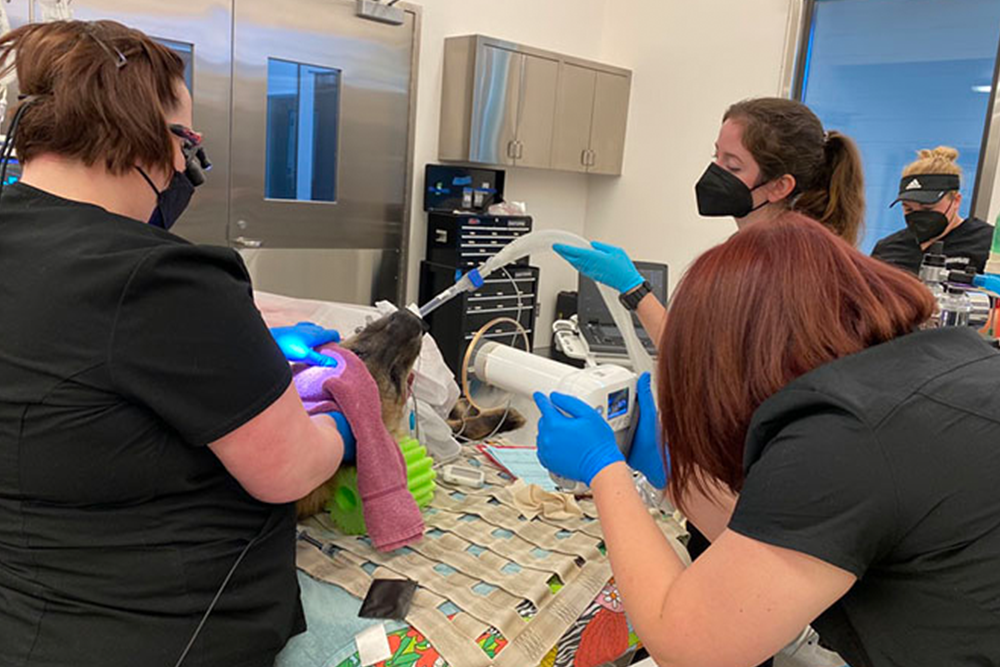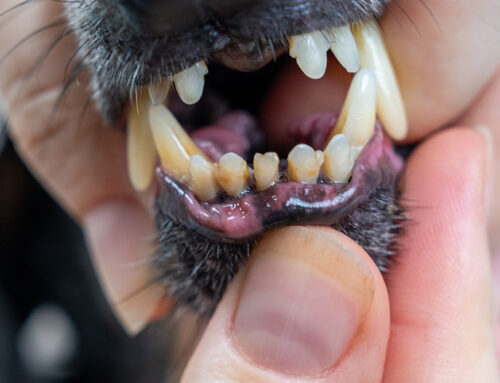Although you can take a peek in your pet’s mouth, their oral health extends beyond what you can see. As much as 60% of each tooth and its supporting structures lie hidden below the gumline, which makes diagnosing infection, injury, and other disease impossible through a visual examination alone. In addition, unless your pet is anesthetized, they will likely not be amenable to a full-mouth exam (feeling around each tooth, all the way in the back, against the tongue, etc), which makes spotting potential problems more challenging.
Fortunately, veterinary dentistry, particularly at advanced specialty practices, has come a long way and is on par with practices that maintain people’s oral health. The North Bay Veterinary Dentistry team is exceptionally proud of the advanced diagnostic tools that we use to identify pets’ oral pain and infection sources. In addition to our highly skilled veterinary team, we use digital dental X-ray and cone beam computed tomography (CBCT) to make accurate diagnoses and effective treatment plans. Read our team’s guide to learn about these dental diagnostic imaging tools, and why they are so important to your pet’s oral health.
Digital dental X-ray and your pet
Digital dental X-ray is becoming increasingly common in veterinary medicine, although not every hospital offers this critical diagnostic imaging tool. X-rays are essential for assessing the tooth’s structure that lies below the gumline as well as the health of the structures that support the tooth (the periodontal structures). These images are also beneficial for detecting issues above the gumline that are difficult to detect through periodontal probing alone if your pet’s teeth are crowded.
When our team X-rays your pet’s mouth, the results reveal two-dimensional images of the teeth and bony supporting structures. We are generally unable to evaluate the oral soft tissues by taking X-rays. However, through dental X-rays, we can identify:
- Tooth fractures
- Retained teeth
- Resorptive disease
- Tooth-root fragments
- Tooth-root abscesses
- Bone loss
By using dental X-ray our team can also evaluate the progress we are making during oral surgery and other treatments like bone grafts, or root canal. If we need to extract a diseased tooth, X-ray images are necessary to ensure we leave behind no root fragments.
Cone beam computed tomography and your pet
While X-ray provides a two-dimensional image of the teeth and surrounding bony structures, Cone Beam Computed Tomography provides an extra level of diagnostic accuracy. During a CBCT scan, the system rotates around your pet’s head, taking a series of images using a cone-shaped X-ray beam. These images form a highly detailed picture of your pet’s skull, from their nose to their ears (and sometimes further), including details about soft tissue structures. By performing CBCT, our North Bay Veterinary Dentistry team can visualize the entire skull, including the lymph nodes, tongue, eyes, and ears. We can also see inside areas, such as the sinus cavities and ear canals, to check for any abnormalities.
CBCT is a much more sensitive tool than X-ray and is what we use as our primary diagnostic method. While CBCT can detect the same periodontal problems that X-ray can, such as abscesses and bone loss, CBCT enables us to catch issues that are in an early stage and pinpoint their exact shape, size, and location within the skull. This advanced diagnostic imaging tool can also detect conditions that can be difficult or impossible to visualize through X-ray alone. Some conditions CBCT can diagnose and evaluate include oral tumors, cleft palates, jaw fractures, TMJ disease and cysts. Understanding the extent of these issues through highly detailed, noninvasive imaging allows our team to provide a more informed prognosis, and proceed with advanced treatments that general veterinary practices are unable to provide.
CBCT technology exposes your pet to less radiation than dental X-ray, takes less time, and requires fewer scans to reveal a great deal of information, making CBCT the gold standard of dental diagnostic tools. While we primarily use CBCT for our patients, both diagnostic modalities have their benefits, and when we use both of these imaging tools, we can get your pet’s most complete oral health picture.
If your family veterinarian does not perform digital dental X-ray, they cannot accurately assess your pet’s oral health. To get to the root of your furry pal’s periodontal problem, schedule a comprehensive oral assessment, including digital imaging, with our North Bay Veterinary Dentistry team.






Leave A Comment